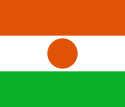UTC+01:00
UTC+01:00 (A – Alpha) – strefa czasowa, odpowiadająca czasowi słonecznemu południka 15°E.
Do strefy czasowej UTC+01:00 należy czas środkowoeuropejski (CET, Central European Time), czas zachodnioafrykański (WAT, West Africa Time), czas zachodnioeuropejski letni (WEST, Western European Summer Time), czas brytyjski letni (BST, British Summer Time).
W strefie znajduje się m.in. Amsterdam, Berlin, Bruksela, Casablanca, Kinszasa, Lagos, Madryt, Oslo, Paryż, Rzym, Warszawa i Wiedeń.
Strefa całoroczna
Afryka:
 Algieria
Algieria Angola
Angola Benin
Benin Czad
Czad Demokratyczna Republika Konga (Kinszasa oraz prowincje: Kongo Środkowe, Kwango, Kwilu, Mai-Ndombe, Mongala, Prowincja Równikowa, Tshuapa, Ubangi Północne i Ubangi Południowe)
Demokratyczna Republika Konga (Kinszasa oraz prowincje: Kongo Środkowe, Kwango, Kwilu, Mai-Ndombe, Mongala, Prowincja Równikowa, Tshuapa, Ubangi Północne i Ubangi Południowe) Gabon
Gabon Gwinea Równikowa
Gwinea Równikowa Kamerun
Kamerun Kongo
Kongo Maroko (oprócz Ramadanu)
Maroko (oprócz Ramadanu) Niger
Niger Nigeria
Nigeria Republika Środkowoafrykańska
Republika Środkowoafrykańska Tunezja
Tunezja
Czas standardowy (zimowy) na półkuli północnej
Europa:
 Albania
Albania Andora
Andora Austria
Austria Belgia
Belgia Bośnia i Hercegowina
Bośnia i Hercegowina Chorwacja
Chorwacja Czarnogóra
Czarnogóra Czechy
Czechy Dania
Dania Francja
Francja Gibraltar
Gibraltar Hiszpania
Hiszpania Holandia
Holandia Kosowo
Kosowo Liechtenstein
Liechtenstein Luksemburg
Luksemburg Macedonia Północna
Macedonia Północna Malta
Malta Monako
Monako Niemcy
Niemcy Norwegia
Norwegia Polska
Polska San Marino
San Marino Serbia
Serbia Słowacja
Słowacja Słowenia
Słowenia Szwajcaria
Szwajcaria Szwecja
Szwecja Watykan
Watykan Węgry
Węgry Włochy
Włochy
Czas standardowy (zimowy) na półkuli południowej
Obecnie na półkuli południowej nie stosuje się czasu letniego lub zimowego w żadnej strefie UTC +1:00. W latach 1994–2017 czas zimowy stosowała Namibia.
Czas letni na półkuli północnej
Afryka:
Europa:
 Guernsey
Guernsey Irlandia
Irlandia Jersey
Jersey Portugalia (z wyłączeniem Azorów)
Portugalia (z wyłączeniem Azorów) Wielka Brytania
Wielka Brytania Wyspa Man
Wyspa Man Wyspy Owcze
Wyspy Owcze
Linki zewnętrzne
- World Time Zone Map (ang.)
Media użyte na tej stronie
The national flag of the Democratic Republic of the Congo. Created according to the 2006 constitution : Son emblème est le drapeau bleu ciel, orné d’une étoile jaune dans le coin supérieur gauche et traversé en biais d’une bande rouge finement encadrée de jaune. (Its symbol is a sky blue flag, decorated with a yellow star in the upper left corner and crossed in the diagonal by a red strip with thin yellow borders) It seems to be identical, except for a lighter field hue, to the 1966–1971 flag.
Please do not replace the simplified code by a version created with Inkscape or another vector graphics editor❗
The proportions of this flag are 3:2; however, there is no official definition for the correct proportions and also 5:3 is widely used.
Flag of Albania
Łatwo można dodać ramkę naokoło tej grafiki
Flag of Gibraltar
Autor: Pedro A. Gracia Fajardo, escudo de Manual de Imagen Institucional de la Administración General del Estado, Licencja: CC0
Flaga Hiszpanii
Flag of Liechtenstein
Flag of Portugal, created by Columbano Bordalo Pinheiro (1857-1929), officially adopted by Portuguese government in June 30th 1911 (in use since about November 1910). Color shades matching the RGB values officially reccomended here. (PMS values should be used for direct ink or textile; CMYK for 4-color offset printing on paper; this is an image for screen display, RGB should be used.)
The flag of the United Kingdom (3:5 version). This flag is the Union Flag in the 3:5 ratio exclusively used on land. At sea, the correct ratio is 1:2.
Standard time zones of the world.png highlighting UTC+1 Dark blue: UTC+1 Northern Hemisphere Winter/Southern Summer Orange: UTC+1 Northern Hemisphere Summer/Southern Winter Yellow: UTC+1 all year round Light Blue: UTC+1 sea areas






















































